display LINCOLN NAVIGATOR 2010 Navigation Manual
[x] Cancel search | Manufacturer: LINCOLN, Model Year: 2010, Model line: NAVIGATOR, Model: LINCOLN NAVIGATOR 2010Pages: 194, PDF Size: 1.94 MB
Page 97 of 194

•It is recommended to program the system only when stopped.
•Some functions are unavailable while the vehicle is in motion to help
minimize distraction.
•Please refer to your Owner’s Guide for further details.
•Periodic map updates are available at an additional cost.
MAP MODE
To enter map mode:
1. Ensure that the system is on.
2. Press the MAP hard button on the navigation system. The map screen
will display.
When in MAP mode, an icon appears on the upper left side of the
screen; this is a toggle button to change the view of the map displayed.
The following methods exist for orientation of the map:
•Heading up:In this mode, the
direction of forward travel is
always the upward direction on
screen. Available for map scales up to 2.5 mi /5km. For scales above
that, the setting for Heading-Up is remembered, but the map is shown
in North-Up only. If the scale returns below this level, then the
Heading-Up setting is restored.
•North up:In this mode, the
Northern Direction is always the
upward direction on screen.
MAP SCALE
The map display scale on the map
has 12 levels, ranging from
0.02 miles to 160 miles. In MAP
mode, you can also zoom in or out,
changing the display scale by pressing on one of the arrows on the
button appearing on the left side of the screen. When in Full Screen Map
Mode, touching this button will cause the Zoom Direct buttons to appear.
The Zoom Direct buttons represent the most common scales and can be
pressed directly to show the map at the desired scale. The scale is
approximate and based on the width of the display button (A). The size
of the scale will vary based on the screen size.
A
2009 Centerstack(ng1)
Supplement, 2nd Printing
USA(fus)
Setting a destination
96
Page 98 of 194
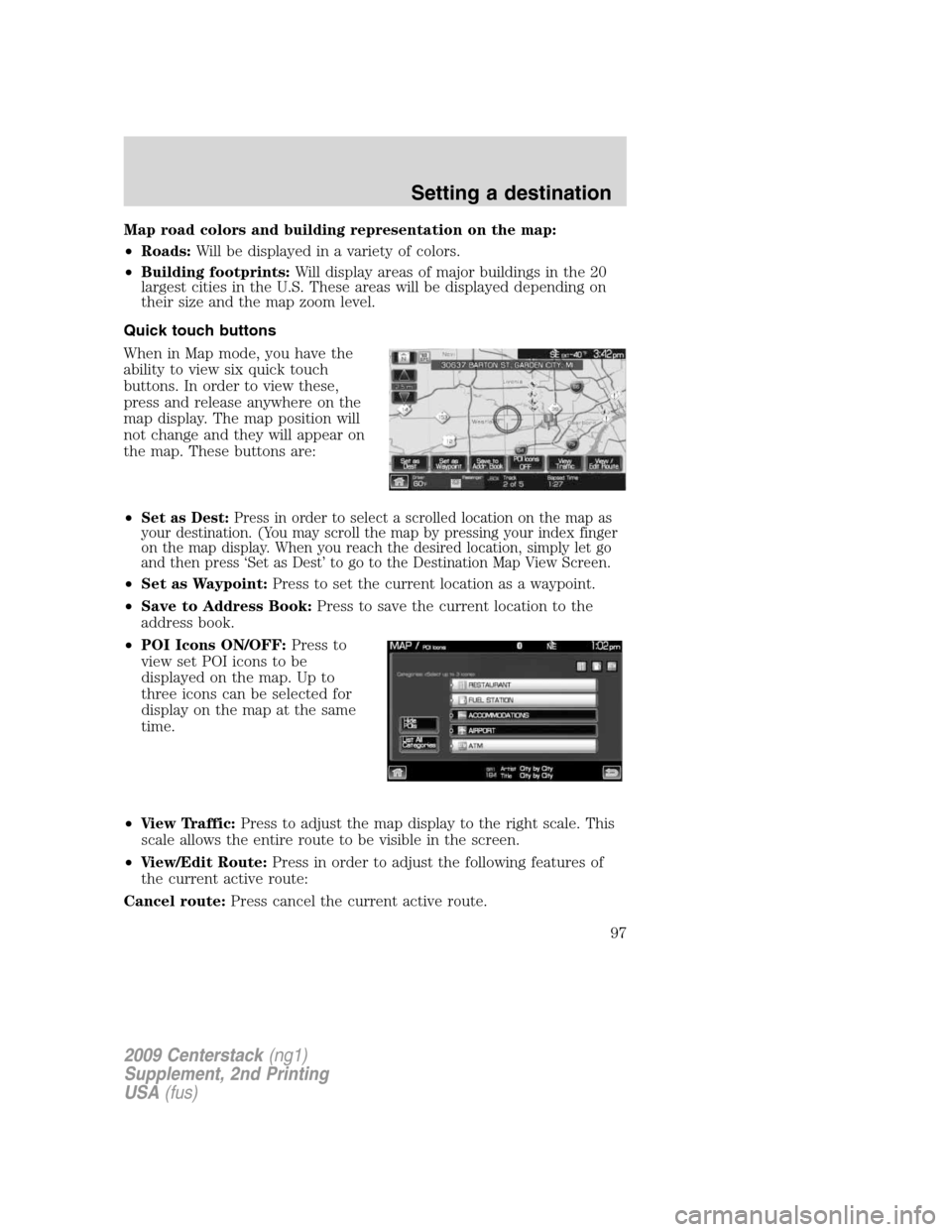
Map road colors and building representation on the map:
•Roads:Will be displayed in a variety of colors.
•Building footprints:Will display areas of major buildings in the 20
largest cities in the U.S. These areas will be displayed depending on
their size and the map zoom level.
Quick touch buttons
When in Map mode, you have the
ability to view six quick touch
buttons. In order to view these,
press and release anywhere on the
map display. The map position will
not change and they will appear on
the map. These buttons are:
•
Set as Dest:Press in order to select a scrolled location on the map as
your destination. (You may scroll the map by pressing your index finger
on the map display. When you reach the desired location, simply let go
and then press ‘Set as Dest’ to go to the Destination Map View Screen.
•Set as Waypoint:Press to set the current location as a waypoint.
•Save to Address Book:Press to save the current location to the
address book.
•POI Icons ON/OFF:Press to
view set POI icons to be
displayed on the map. Up to
three icons can be selected for
display on the map at the same
time.
•View Traffic:Press to adjust the map display to the right scale. This
scale allows the entire route to be visible in the screen.
•View/Edit Route:Press in order to adjust the following features of
the current active route:
Cancel route:Press cancel the current active route.
2009 Centerstack(ng1)
Supplement, 2nd Printing
USA(fus)
Setting a destination
97
Page 99 of 194
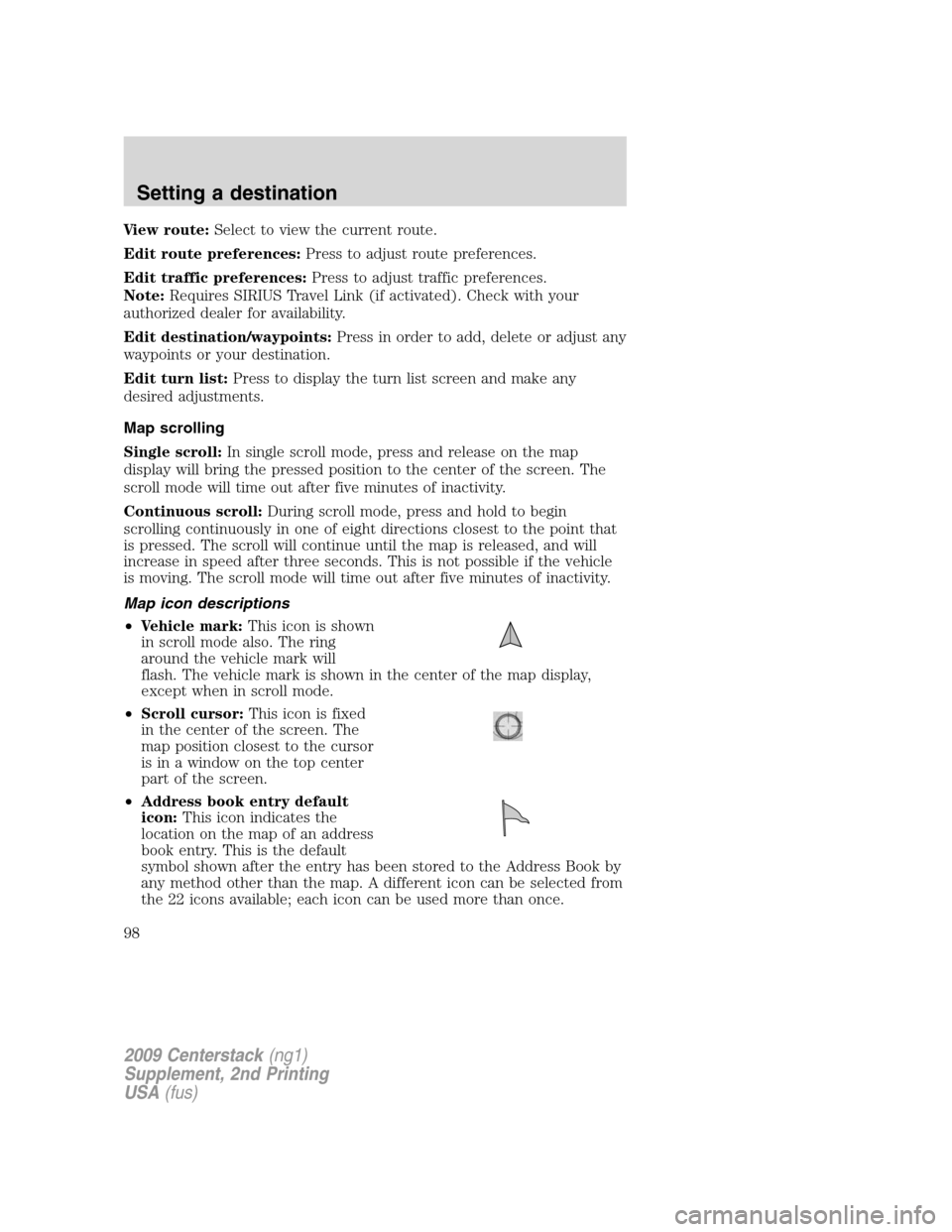
View route:Select to view the current route.
Edit route preferences:Press to adjust route preferences.
Edit traffic preferences:Press to adjust traffic preferences.
Note:Requires SIRIUS Travel Link (if activated). Check with your
authorized dealer for availability.
Edit destination/waypoints:Press in order to add, delete or adjust any
waypoints or your destination.
Edit turn list:Press to display the turn list screen and make any
desired adjustments.
Map scrolling
Single scroll:In single scroll mode, press and release on the map
display will bring the pressed position to the center of the screen. The
scroll mode will time out after five minutes of inactivity.
Continuous scroll:During scroll mode, press and hold to begin
scrolling continuously in one of eight directions closest to the point that
is pressed. The scroll will continue until the map is released, and will
increase in speed after three seconds. This is not possible if the vehicle
is moving. The scroll mode will time out after five minutes of inactivity.
Map icon descriptions
•Vehicle mark:This icon is shown
in scroll mode also. The ring
around the vehicle mark will
flash. The vehicle mark is shown in the center of the map display,
except when in scroll mode.
•Scroll cursor:This icon is fixed
in the center of the screen. The
map position closest to the cursor
is in a window on the top center
part of the screen.
•Address book entry default
icon:This icon indicates the
location on the map of an address
book entry. This is the default
symbol shown after the entry has been stored to the Address Book by
any method other than the map. A different icon can be selected from
the 22 icons available; each icon can be used more than once.
2009 Centerstack(ng1)
Supplement, 2nd Printing
USA(fus)
Setting a destination
98
Page 100 of 194
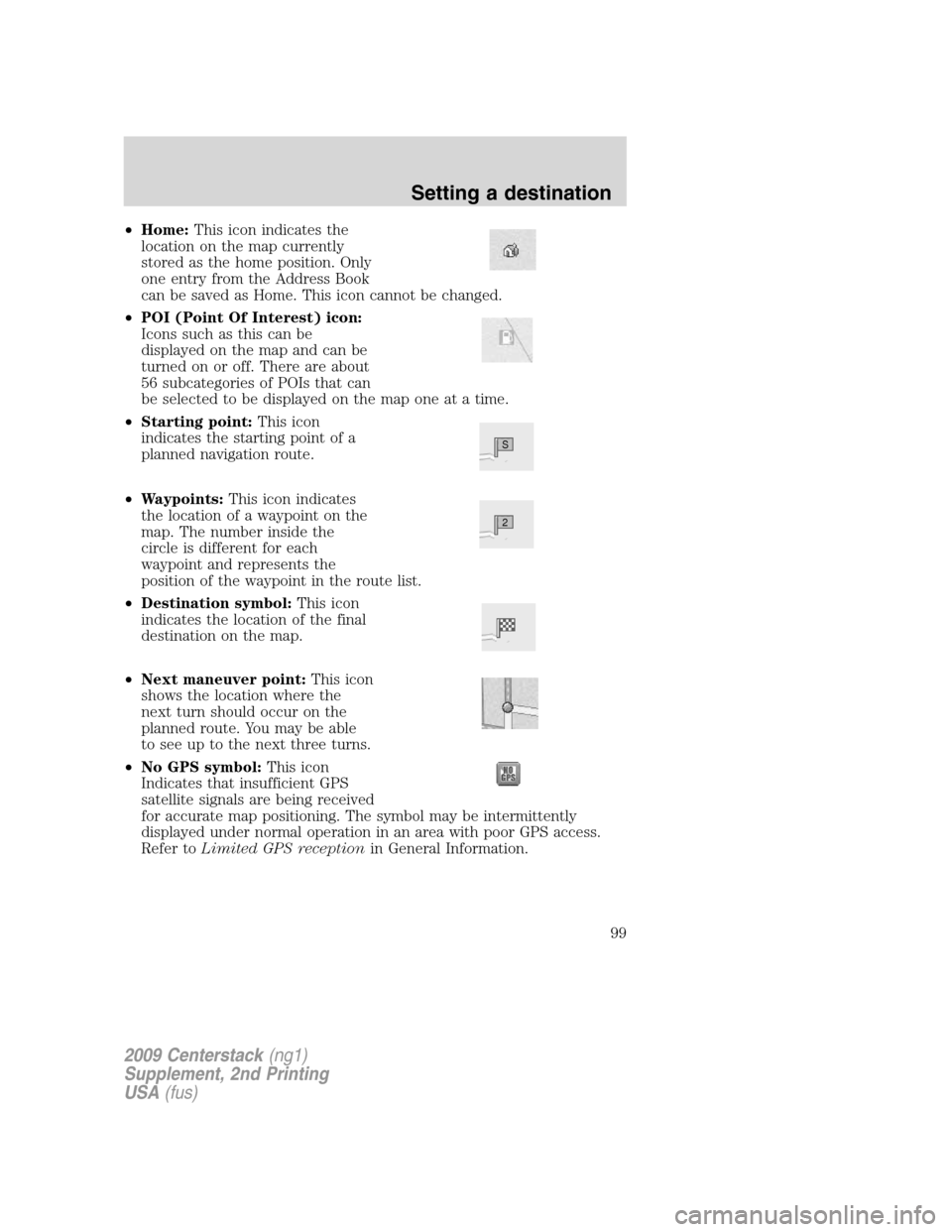
•Home:This icon indicates the
location on the map currently
stored as the home position. Only
one entry from the Address Book
can be saved as Home. This icon cannot be changed.
•POI (Point Of Interest) icon:
Icons such as this can be
displayed on the map and can be
turned on or off. There are about
56 subcategories of POIs that can
be selected to be displayed on the map one at a time.
•Starting point:This icon
indicates the starting point of a
planned navigation route.
•Waypoints:This icon indicates
the location of a waypoint on the
map. The number inside the
circle is different for each
waypoint and represents the
position of the waypoint in the route list.
•Destination symbol:This icon
indicates the location of the final
destination on the map.
•Next maneuver point:This icon
shows the location where the
next turn should occur on the
planned route. You may be able
to see up to the next three turns.
•No GPS symbol:This icon
Indicates that insufficient GPS
satellite signals are being received
for accurate map positioning. The symbol may be intermittently
displayed under normal operation in an area with poor GPS access.
Refer toLimited GPS receptionin General Information.
S
2
2009 Centerstack(ng1)
Supplement, 2nd Printing
USA(fus)
Setting a destination
99
Page 102 of 194
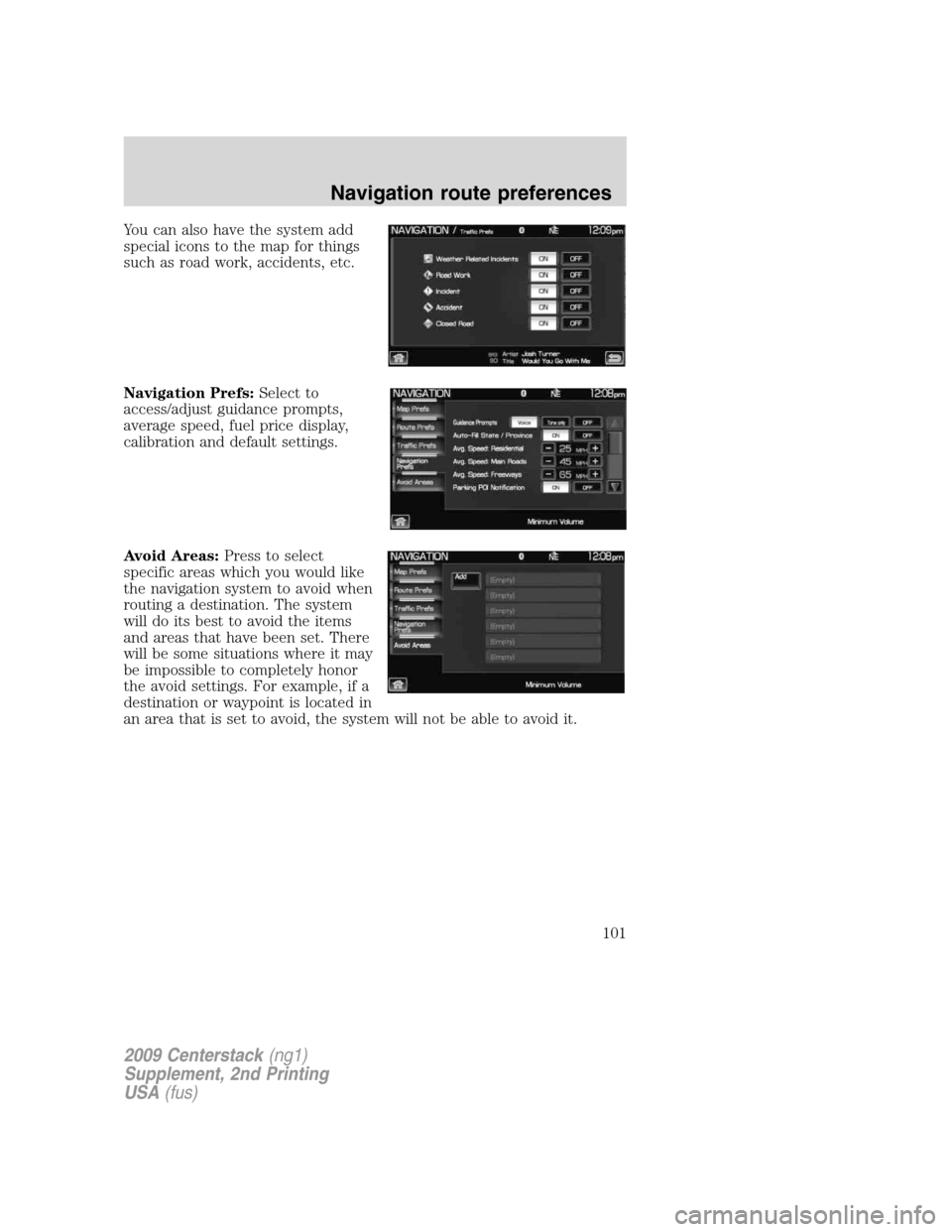
You can also have the system add
special icons to the map for things
such as road work, accidents, etc.
Navigation Prefs:Select to
access/adjust guidance prompts,
average speed, fuel price display,
calibration and default settings.
Avoid Areas:Press to select
specific areas which you would like
the navigation system to avoid when
routing a destination. The system
will do its best to avoid the items
and areas that have been set. There
will be some situations where it may
be impossible to completely honor
the avoid settings. For example, if a
destination or waypoint is located in
an area that is set to avoid, the system will not be able to avoid it.
2009 Centerstack(ng1)
Supplement, 2nd Printing
USA(fus)
Navigation route preferences
101
Page 103 of 194
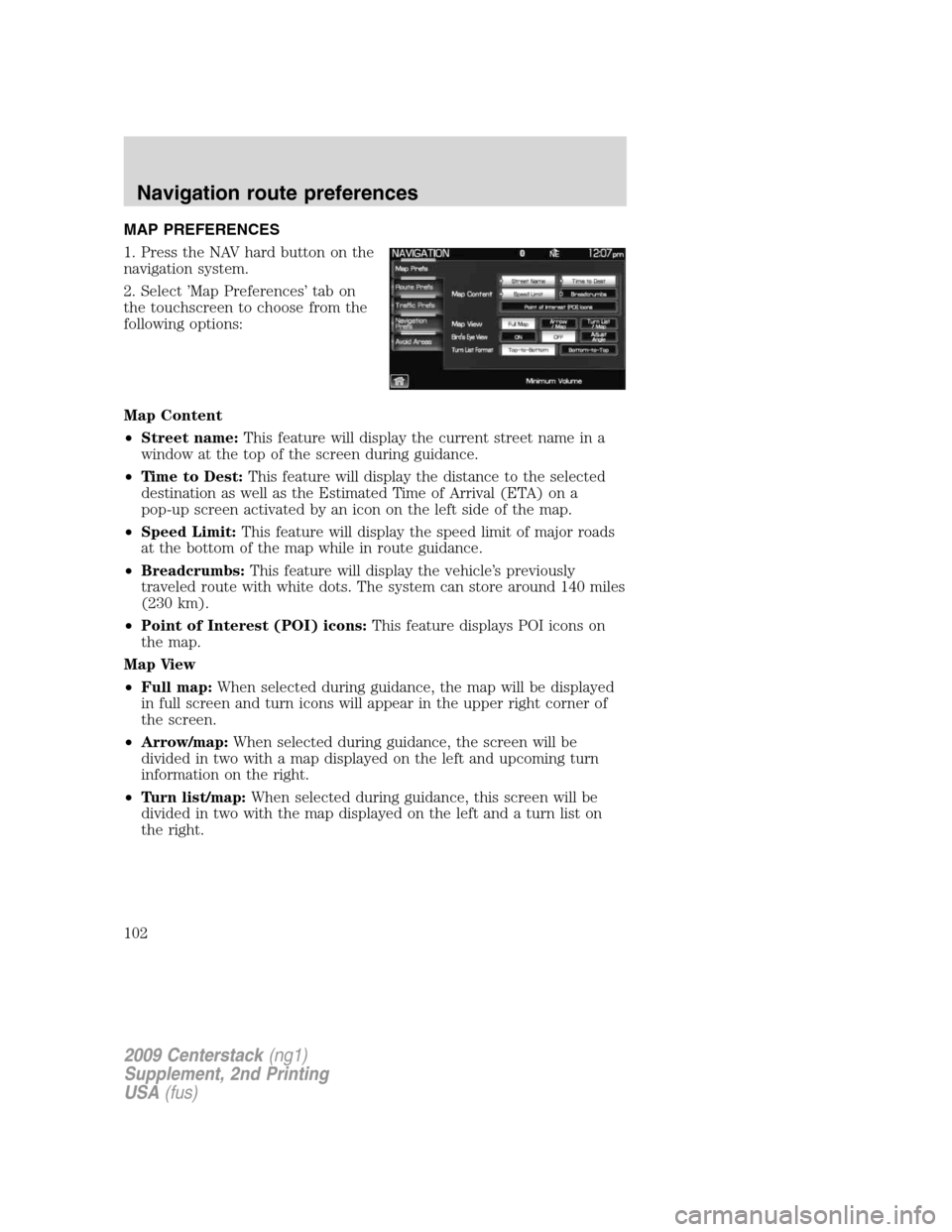
MAP PREFERENCES
1. Press the NAV hard button on the
navigation system.
2. Select ’Map Preferences’ tab on
the touchscreen to choose from the
following options:
Map Content
•Street name:This feature will display the current street name in a
window at the top of the screen during guidance.
•Time to Dest:This feature will display the distance to the selected
destination as well as the Estimated Time of Arrival (ETA) on a
pop-up screen activated by an icon on the left side of the map.
•Speed Limit:This feature will display the speed limit of major roads
at the bottom of the map while in route guidance.
•Breadcrumbs:This feature will display the vehicle’s previously
traveled route with white dots. The system can store around 140 miles
(230 km).
•Point of Interest (POI) icons:This feature displays POI icons on
the map.
Map View
•Full map:When selected during guidance, the map will be displayed
in full screen and turn icons will appear in the upper right corner of
the screen.
•Arrow/map:When selected during guidance, the screen will be
divided in two with a map displayed on the left and upcoming turn
information on the right.
•Turn list/map:When selected during guidance, this screen will be
divided in two with the map displayed on the left and a turn list on
the right.
2009 Centerstack(ng1)
Supplement, 2nd Printing
USA(fus)
Navigation route preferences
102
Page 104 of 194

Bird’s eye view
•On:Select to enable the Bird’s
eye view feature when the map
screen is displayed. This view
provides an elevated perspective.
•Off:Select to disable the Bird’s
eye view feature.
•Adjust angle:Select to adjust
the angle of the Bird’s eye view.
You have six different options.
Turn list format
•Top-to-bottom:Select to have the turn instructions begin at the top
and work down.
•Bottom-to-top:Select to have the turn instructions begin at the
bottom and work up.
ROUTE PREFERENCES
Your navigation system can search for up to three different routes. You
can select from the fastest route, the shortest route, or the ‘unrestricted’
route which does not consider any ‘avoid’ areas which may have been
selected. If there are not any ‘avoid’ settings, the system will only
produce two possible routes. You can select the order in which the
routes are displayed. The system will automatically avoid unpaved roads
as much as possible. To access:
1. Press the NAV hard button on the navigation system.
2009 Centerstack(ng1)
Supplement, 2nd Printing
USA(fus)
Navigation route preferences
103
Page 105 of 194
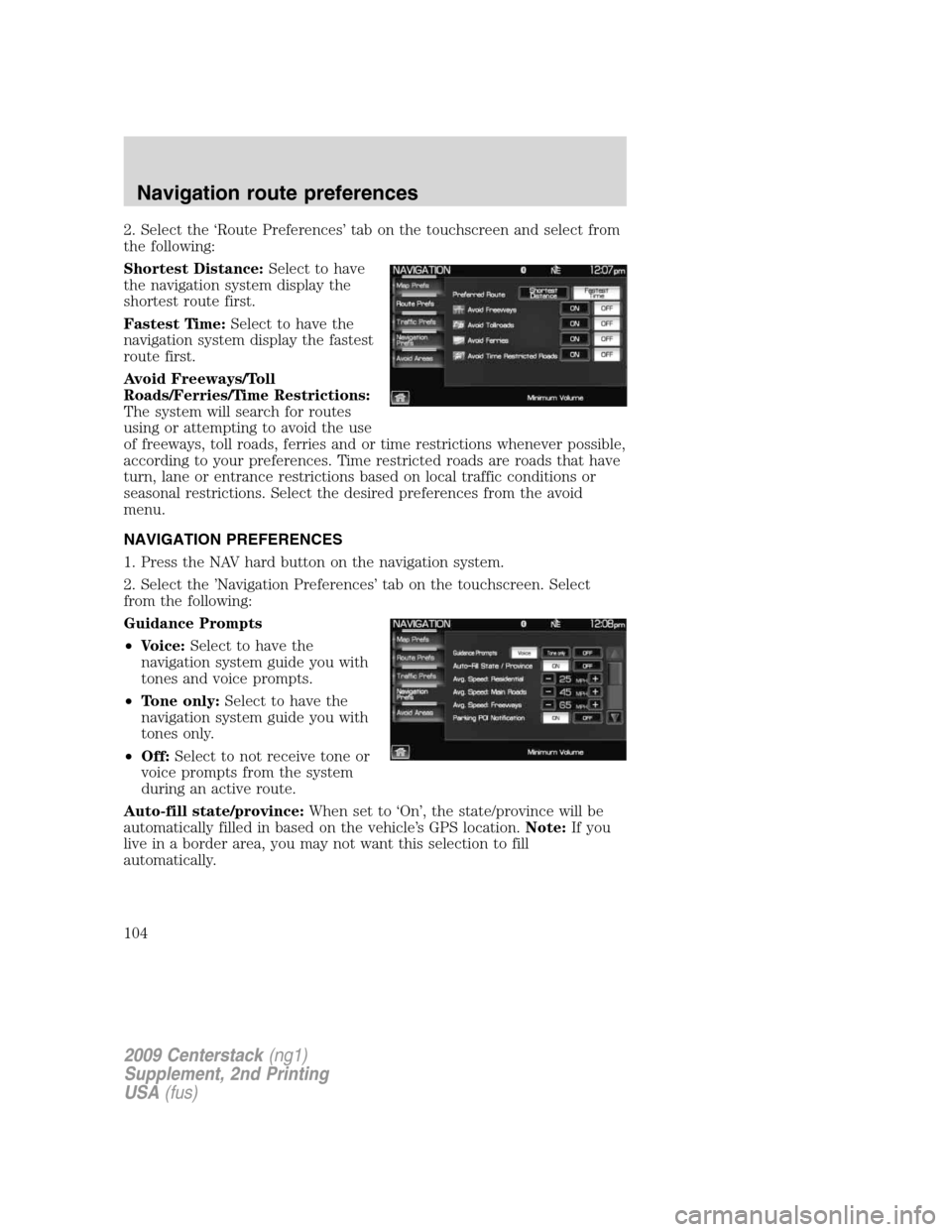
2. Select the ‘Route Preferences’ tab on the touchscreen and select from
the following:
Shortest Distance:Select to have
the navigation system display the
shortest route first.
Fastest Time:Select to have the
navigation system display the fastest
route first.
Avoid Freeways/Toll
Roads/Ferries/Time Restrictions:
The system will search for routes
using or attempting to avoid the use
of freeways, toll roads, ferries and or time restrictions whenever possible,
according to your preferences. Time restricted roads are roads that have
turn, lane or entrance restrictions based on local traffic conditions or
seasonal restrictions. Select the desired preferences from the avoid
menu.
NAVIGATION PREFERENCES
1. Press the NAV hard button on the navigation system.
2. Select the ’Navigation Preferences’ tab on the touchscreen. Select
from the following:
Guidance Prompts
•Voice:Select to have the
navigation system guide you with
tones and voice prompts.
•Tone only:Select to have the
navigation system guide you with
tones only.
•Off:Select to not receive tone or
voice prompts from the system
during an active route.
Auto-fill state/province:When set to ‘On’, the state/province will be
automatically filled in based on the vehicle’s GPS location.Note:If you
live in a border area, you may not want this selection to fill
automatically.
2009 Centerstack(ng1)
Supplement, 2nd Printing
USA(fus)
Navigation route preferences
104
Page 106 of 194
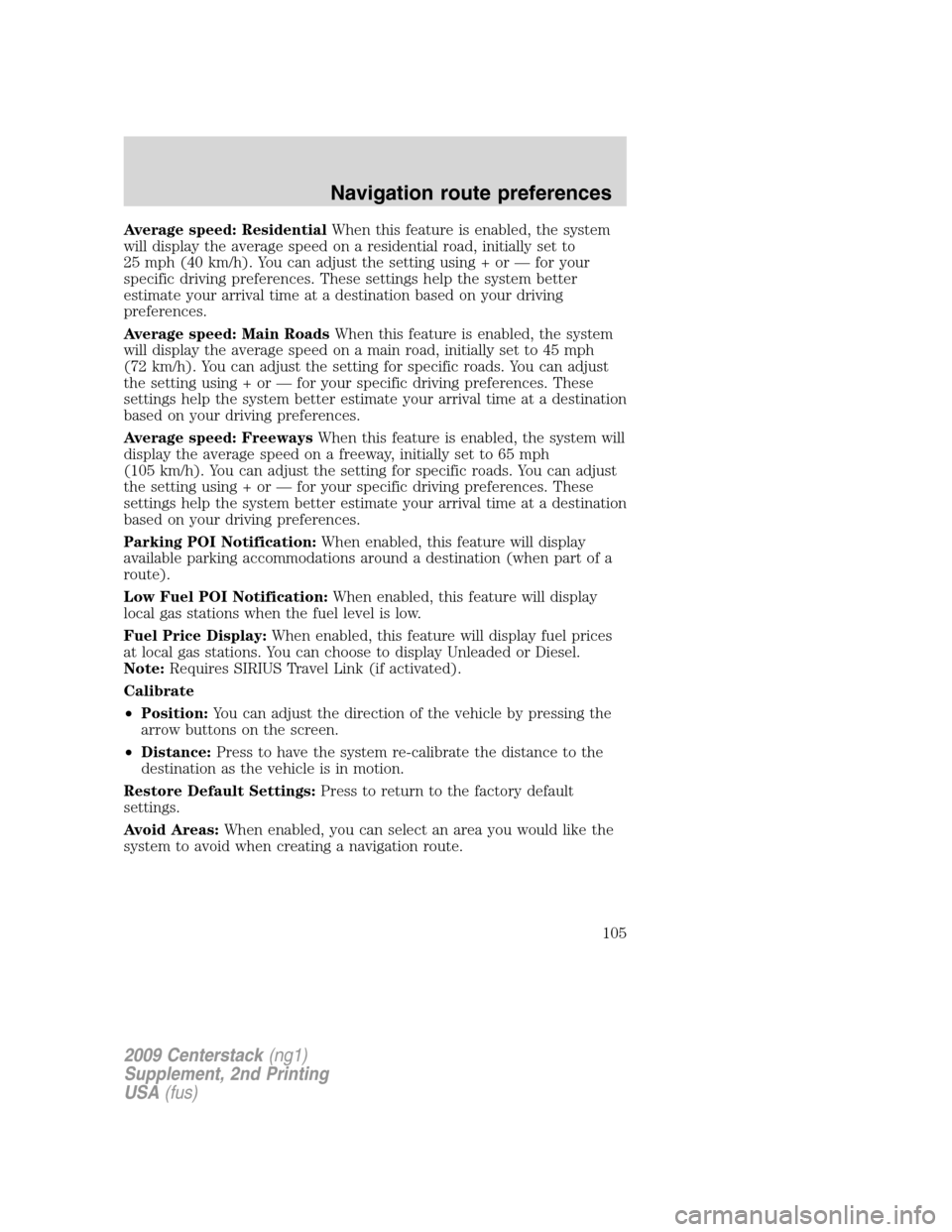
Average speed: ResidentialWhen this feature is enabled, the system
will display the average speed on a residential road, initially set to
25 mph (40 km/h). You can adjust the setting using + or — for your
specific driving preferences. These settings help the system better
estimate your arrival time at a destination based on your driving
preferences.
Average speed: Main RoadsWhen this feature is enabled, the system
will display the average speed on a main road, initially set to 45 mph
(72 km/h). You can adjust the setting for specific roads. You can adjust
the setting using + or — for your specific driving preferences. These
settings help the system better estimate your arrival time at a destination
based on your driving preferences.
Average speed: FreewaysWhen this feature is enabled, the system will
display the average speed on a freeway, initially set to 65 mph
(105 km/h). You can adjust the setting for specific roads. You can adjust
the setting using + or — for your specific driving preferences. These
settings help the system better estimate your arrival time at a destination
based on your driving preferences.
Parking POI Notification:When enabled, this feature will display
available parking accommodations around a destination (when part of a
route).
Low Fuel POI Notification:When enabled, this feature will display
local gas stations when the fuel level is low.
Fuel Price Display:When enabled, this feature will display fuel prices
at local gas stations. You can choose to display Unleaded or Diesel.
Note:Requires SIRIUS Travel Link (if activated).
Calibrate
•Position:You can adjust the direction of the vehicle by pressing the
arrow buttons on the screen.
•Distance:Press to have the system re-calibrate the distance to the
destination as the vehicle is in motion.
Restore Default Settings:Press to return to the factory default
settings.
Avoid Areas:When enabled, you can select an area you would like the
system to avoid when creating a navigation route.
2009 Centerstack(ng1)
Supplement, 2nd Printing
USA(fus)
Navigation route preferences
105
Page 114 of 194

PRINCIPLES OF GPS
Your system directs you based on information derived from global
positioning satellites, road maps stored on the hard disk drive, sensors in
your vehicle and the desired destination. The system compiles all
necessary information to guide you to your selected destination. Space
satellites determine the vehicle’s current location and transmit position
and time signals to your car. If the vehicle has been parked for a long
period of time, the navigation function may be temporarily unresponsive.
The navigation system will operate reliably again once GPS reception is
available for a few minutes.
LIMITED GPS RECEPTION
System performance may be adversely affected if GPS reception is
interrupted or interference occurs over a distance of several miles. The
following are possible causes for GPS reception being interrupted. If the
vehicle is:
•In multi-story parking garages
•In tunnels and under bridges
•Inside or in between buildings
•By forests or tree-lined avenues
•In heavy rain showers and thunderstorms
•In valleys and in mountainous regions
•Roads under cliffs
Ensure that you do not have any metal objects on the dashboard and
that if your windows are tinted, they use non-metal tinting instead of
metal oxide tinting. Both of these factors can also interrupt GPS
reception.
SYSTEM LIMITATIONS
Cold temperature start:When operating the system below 32° F
(0°C), the display screen requires a 2–3 minutes warm-up time to
achieve maximum brightness.
Other conditions:When calculating a route, the system doesn’t take
into consideration any of the following conditions:
•Traffic Conditions
•Weather Conditions
•Driving Habits
2009 Centerstack(ng1)
Supplement, 2nd Printing
USA(fus)
General Information
113